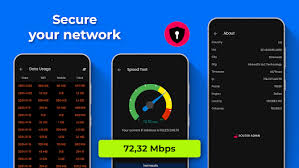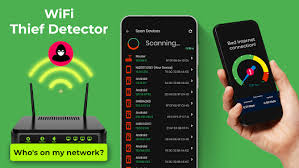Introduction:
Picture this: you’re cozied up, ready to binge-watch your favorite series, when—bam!—your screen freezes, and your WiFi decides it’s on a coffee break. Sound familiar?
You might be wondering, Is someone stealing my WiFi? With over 4.9 billion internet users globally, WiFi piggybacking is as common as sneaky squirrels raiding a bird feeder. Whether it’s a nosy neighbor, a tech-savvy teen, or even a random passerby, unauthorized users can slow your connection, spike your data usage, and even pose security risks.
Fear not! This comprehensive guide will equip you with foolproof ways to detect WiFi thieves using tools like a detect WiFi thief app, router tricks, and more. Written for all ages, with a conversational tone and a pinch of humor, you’ll learn how to reclaim your bandwidth and secure your network like a pro. Let’s dive into this digital detective mission!
Why Check for WiFi Thieves?
Your WiFi is like a freshly baked batch of cookies—everyone wants a piece! Unauthorized users can gobble up your bandwidth, leaving your internet sluggish and your streaming sessions in shambles. Worse, WiFi thieves might access sensitive data, like banking details or personal files, if your network isn’t secure.
A detect WiFi thief app can help you spot these digital freeloaders, ensuring your connection stays fast and safe. In 2025, with cyber threats evolving faster than fashion trends, securing your WiFi is as essential as locking your front door. This guide will walk you through spotting and stopping WiFi thieves, no matter your tech expertise. Let’s get started!
Signs Someone’s Using Your WiFi
Before you channel your inner Sherlock Holmes, watch for these clues that someone’s sneaking onto your WiFi.
Slow Internet Speeds
Is your internet moving slower than a sloth on a lazy Sunday? Sudden slowdowns, especially during peak hours, could mean someone’s hogging your bandwidth. While it might be your ISP or too many devices at home, a detect WiFi thief app can confirm if an intruder’s the culprit. Slow speeds are often the first hint of WiFi theft, so don’t ignore them!
Unfamiliar Devices
Ever spotted a device named “SneakyPhone” or “UnknownLaptop” on your network? That’s a glaring red flag! Checking connected devices is a quick way to catch WiFi thieves. Later, we’ll show you how to use your router or a detect WiFi thief app to identify these mystery gadgets.
Unexpected Data Usage
If your internet bill spikes or your data cap vanishes faster than free samples at a grocery store, someone might be overusing your WiFi. Streaming, gaming, or downloading large files by an unauthorized user can rack up data. Check your router’s usage stats or use a detect WiFi thief app to investigate.
Read more: Phone Overheating: The Shocking Truth & How to Fix It (2025)
How to Detect WiFi Thieves
Ready to play WiFi detective? Here are four reliable methods to uncover those bandwidth bandits, explained for all ages.
Use Your Router’s Admin Panel
Your router is the nerve center of your network, and its admin panel is your command hub. Here’s a step-by-step guide to check for intruders:
-
Find Your Router’s IP Address: It’s usually 192.168.0.1 or 192.168.1.1. Check the router’s label or manual if unsure.
-
Log In: Open a browser, enter the IP address, and input your username and password (often “admin” and “password” by default—change these!).
-
Check Connected Devices: Look for sections like “Device List,” “Connected Devices,” or “DHCP Clients.” This shows all devices on your network.
-
Identify Intruders: Compare the list to your household devices. Spot an unfamiliar name or MAC address? That’s your WiFi thief!
If you’re new to routers, our router setup guide has more tips.

Try a Detect WiFi Thief App
Not keen on diving into router settings? A detect WiFi thief app is your go-to solution. These apps are user-friendly, perfect for teens, parents, or grandparents. They scan your network, list connected devices, and even let you block intruders. Here are some top picks:
-
Fing: Displays device names, IP addresses, and offers blocking features. Available on iOS and Android.
-
NetCut: Ideal for Android and Windows users, it monitors and removes unwanted devices.
-
WiFi Analyzer: Focuses on network scanning and signal strength but includes intruder detection.
-
Who’s On My WiFi: A simple app for quick scans and device identification.
Download these from trusted sources like the Google Play Store or Apple App Store. Run a scan, and you’ll see if someone’s sneaking onto your WiFi.
For more app recommendations, check our network monitoring tools guide.
Check Network Logs
For those who love a tech challenge, network logs offer a deeper look. Access your router’s admin panel and find the “Logs” or “System Log” section. Logs show connection history, including IP addresses, MAC addresses, and timestamps. Look for unfamiliar IPs or unusual activity, like connections at odd hours. Tools like Wireshark can analyze traffic but are complex—stick to a detect WiFi thief app for simplicity.
Monitor Bandwidth Usage
Some routers display bandwidth usage per device, helping you spot data hogs. Check your router’s “Traffic Monitor” or “Bandwidth Usage” section. If an unknown device is guzzling data, it’s likely a WiFi thief. Apps like GlassWire or a detect WiFi thief app can also track usage, making it easier to pinpoint culprits.
Read more: WiFi Thief Detector – Apps on Google Play
Secure Your WiFi Network
Caught a WiFi thief? Time to fortify your network like a digital fortress. These steps will keep intruders out for good.
Change Your Password
A weak password is an open invitation for WiFi thieves. Here’s how to lock it down:
-
Create a Strong Password: Use a mix of letters, numbers, and symbols (e.g., “W1f1S3cur3_2025”). Aim for 12+ characters.
-
Update Regularly: Change it every 6–12 months or after suspecting a breach.
-
Avoid Defaults: Never use “admin” or “password”—they’re hacker bait.
Need help? Our password security guide has more tips.
Enable Encryption
Encryption is your WiFi’s bodyguard, scrambling data to keep it safe. Use WPA3 (or WPA2 if WPA3 isn’t available)—older WEP is as secure as a screen door on a submarine. Check your router’s security settings and update to the strongest encryption.
Disable WPS
WiFi Protected Setup (WPS) makes connecting devices easy but can be a hacker’s backdoor. Disable WPS in your router’s settings to prevent unauthorized access. It’s a small step with big security benefits.

Set Up a Guest Network
Want to share WiFi with visitors without risking your main network? Set up a guest network. Most routers support this feature, letting guests connect without accessing your devices or data. Name it something fun like “GuestZilla” and set a unique password.
Best Apps to Detect WiFi Thieves
Here’s a detailed table comparing top detect WiFi thief apps for 2025:
|
App Name |
Platform |
Key Features |
Price |
Ease of Use |
|---|---|---|---|---|
|
Fing |
iOS, Android |
Device detection, blocking, alerts |
Free/Premium |
Beginner |
|
NetCut |
Android, Windows |
Intruder removal, network control |
Free |
Intermediate |
|
WiFi Analyzer |
Android |
Network scanning, signal analysis |
Free |
Beginner |
|
Who’s On My WiFi |
iOS, Android |
Device identification, simple interface |
Free/Premium |
Beginner |
These apps are perfect for all ages, from tech-curious teens to seniors wanting simplicity. For more tools, see our top cybersecurity apps.
Read more: WiFi Detector: Who Use My WiFi – Apps on Google Play
Common WiFi Thief Myths
Let’s bust some myths about WiFi theft to keep you informed:
-
Myth: WiFi thieves are always malicious hackers.
Truth: Often, it’s just neighbors or guests who guessed a weak password. A detect WiFi thief app can clarify who’s connected. -
Myth: Changing your WiFi name (SSID) stops thieves.
Truth: Hiding your SSID helps, but without encryption and a strong password, thieves can still find it. -
Myth: Only tech experts can detect WiFi thieves.
Truth: With a detect WiFi thief app or router settings, anyone can spot intruders.
Preventing Future WiFi Theft
Stay one step ahead of WiFi thieves with these proactive tips:
-
Hide Your SSID: Make your WiFi invisible to casual scanners by disabling SSID broadcast in your router settings.
-
Use MAC Address Filtering: Allow only approved devices by adding their MAC addresses to your router’s whitelist.
-
Enable Alerts: Some routers or apps like Fing send alerts when new devices connect. Turn this on for real-time monitoring.
-
Regular Scans: Run a detect WiFi thief app weekly or monthly to catch intruders early.
-
Update Firmware: Keep your router’s firmware updated to patch security holes. Check your router’s admin panel for updates.
For more prevention tips, visit CNET’s WiFi security guide.
FAQs
1. Can I see what websites someone visits on my WiFi?
WiFi owners can view domain names (e.g., netflix.com) if router logging is enabled, but HTTPS encryption hides specific pages or content. Use a detect WiFi thief app to monitor devices, not detailed browsing history, for quick intruder detection.
2. How do I block someone from my WiFi network?
Access your router’s admin panel, locate the device list, and block the intruder’s MAC address. Alternatively, apps like Fing let you block unauthorized devices with a tap. A detect WiFi thief app simplifies the process for all users.
3. Can a VPN hide my activity on someone’s WiFi?
Yes, a VPN encrypts your traffic, so WiFi owners only see you’re connected to a VPN server, not specific sites. Use a detect WiFi thief app to identify VPN users, but you can’t view their browsing details.
4. Is it legal to monitor my own WiFi network?
Monitoring your WiFi is legal for security or parental control purposes. However, hacking devices or accessing private data is illegal. Stick to a detect WiFi thief app or router settings to stay within legal boundaries.
5. How often should I check for WiFi thieves?
Check monthly or when you notice slowdowns or odd activity. A detect WiFi thief app makes quick scans easy, and setting up router alerts for new device connections keeps you proactive without much effort.
Conclusion
Nobody enjoys a WiFi freeloader crashing their internet party! Whether it’s sluggish speeds, unfamiliar devices, or skyrocketing data usage, WiFi thieves can be a real headache. By using a detect WiFi thief app, checking your router’s admin panel, monitoring logs, or tracking bandwidth, you can catch those sneaky bandwidth bandits in the act. Secure your network with strong passwords, WPA3 encryption, and a guest network to keep intruders out for good. These tips are simple enough for teens streaming TikToks, parents managing smart homes, or grandparents browsing recipes. Take charge of your WiFi today for a faster, safer connection. Have a WiFi thief story or a favorite app? Drop it in the comments below—we’d love to hear from you!


В этой статье собраны факты, которые освещают целый ряд важных вопросов. Мы стремимся предложить читателям четкую, достоверную информацию, которая поможет сформировать собственное мнение и лучше понять сложные аспекты рассматриваемой темы.
Получить дополнительные сведения – https://vyvod-iz-zapoya-1.ru/